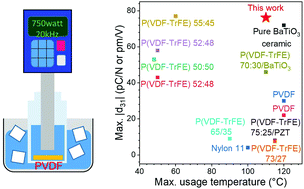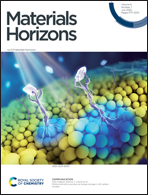Hard-to-soft transition-enhanced piezoelectricity in poly(vinylidene fluoride) via relaxor-like secondary crystals activated by high-power ultrasonication†
Abstract
Although high piezoelectric coefficients have recently been observed in poly(vinylidene fluoride-co-trifluoroethylene) [P(VDF-TrFE)] random copolymers, they have low Curie temperatures, which makes their piezoelectricity thermally unstable. It has been challenging to achieve high piezoelectric performance from the more thermally stable PVDF homopolymer. In this report, we describe how high-power ultrasonic processing was used to induce a hard-to-soft piezoelectric transition and improve the piezoelectric coefficient d31 in neat PVDF. After high-power ultrasonication for 20 min, a uniaxially stretched and poled PVDF film exhibited a high d31 of 50.2 ± 1.7 pm V−1 at room temperature. Upon heating to 65 °C, the d31 increased to a maximum value of 76.2 ± 1.2 pm V−1, and the high piezoelectric performance persisted up to 110 °C. The enhanced piezoelectricity was attributed to the relaxor-like secondary crystals in the oriented amorphous fraction, broken off from the primary crystals by ultrasonication, as suggested by differential scanning calorimetry and broadband dielectric spectroscopy studies.



 Please wait while we load your content...
Please wait while we load your content...